Ecbatana
| Author:Laxman Burdak, IFS (R) |
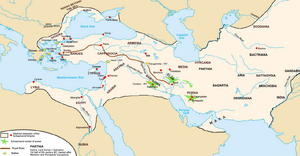
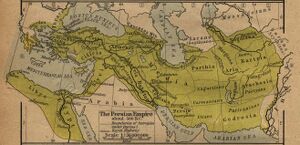
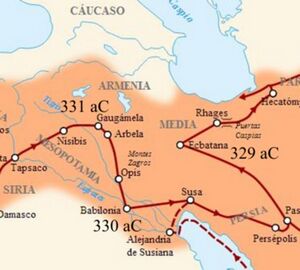
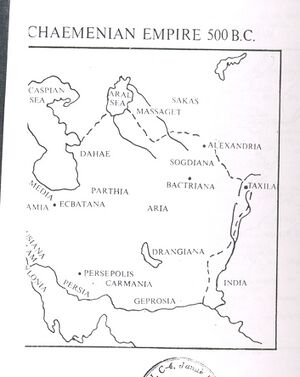
Ecbatana (Hindi: एकबाताना) was an ancient city, which was first the capital of Media in western Iran,[1] and later was an important city in Persian, Seleucid, and Parthian empires.[2] Literally it means the place of gathering. Ecbatana was the capital of Media. The present city of Hamadan is on the same site. [3]
Location
It is situated at the foot of Mount Orontes, and was used by the Persian and Parthian kings as their summer residence. It is believed that Ecbatana is located in the Zagros Mountains, the east of central Mesopotamia,[4] on Hagmatana Hill (Tappe-ye Hagmatāna), an archaeological mound in modern Hamedan in Zagros mountains.[5]
Variants of name
- Ecbatana (Anabasis by Arrian, p. 179-181, 217, 312, 395 396.)
- Ecbatana (Pliny.vi.16, Pliny.vi.17, Pliny.vi.29)
- Hagmatan (of the Medes and Persians, the modern Hamadan)[6]
- Haŋgmatana (Old Persian)
- Agbatana
- Agámtanu
- Agamatanu (Behistun)
- Ekbatan (Kurdish)
- Hagmatana/Hagmatâna (Behustun Inscription,L.32)
- Chaldee Achmetha
Jat Gotras Namesake
- Aga = Agbatana = Ecbatana (Pliny.vi.16, Pliny.vi.17, Pliny.vi.29)
- Haga = Hagmatana = Ecbatana (Pliny.vi.16, Pliny.vi.17, Pliny.vi.29)
Jat Gotras Namesake
- Aga = Ecbatana (Anabasis by Arrian, p. 179-181, 217, 312, 395 396.)
- Haga = Hagmatana = (Anabasis by Arrian, p. 179-181, 217, 312, 395 396.)
History
Ecbatana's strategic location and resources probably made it a popular site even before the 1st millennium B.C.E.[7] According to Herodotus, Ecbatana was chosen as the Medes' capital in 678 BC by Deioces, the first ruler of the Medes.[8] His intention was to build a palace worthy of the dignity of a king.[9] The Neo-Assyrians do not seem to mention Ecbatana, and it is likely they never penetrated east of the Alvand despite two centuries of involvement in Median areas of the central Zagros.[10] Ecbatana was captured by Cyrus II in 550 B.C, and under the Achaemenid Persian kings and transferred its treasury to Anshan.[11] Ecbatana, situated at the foot of Mount Alvand, became a summer royal residence and treasury until 330 BC.[12] As mentioned in several sources, the city was used as a royal archive because Cyrus's order for the rebuilding of the Jerusalem temple was found in the city.[13] In ancient times, Ecbatana was renowned for its wealth and splendid architecture.[14]
Later, it became the capital of the Parthian kings and was used as a summer residence (whereas Ctesiphon was used as the winter residence),[15] when it became their main mint, producing drachms, tetradrachms, and assorted bronze denominations. The wealth and importance of the city in the Persian Empire are attributed to its location on a crucial crossroads that made it a staging post on the main east–west highway called High-Road.[16] There was a reputation for horses and wheat in the area (Polybius, 5.44.1).[17] Graphite, gold, platinum, antimony, iron, and various minerals are found there; however, the classics mention oil seeps and flares, and there is no evidence of exploitation of resources.[18][19][20]
In 330 BC, Alexander the Great captured the Persian treasury at Ecbatana, and he looted the gold and silver decorations of the palace. The place was the site of the assassination of the Macedonian general Parmenion by his order. [21]
Later, in 305 BC, the city was ruled by Seleucus I, and Mithridates I in 147 BC. In 226 CE, it fell to Ardashir I, and the Muslims, later in 642 CE.[22]The city was destroyed around 1220 by the Mongols invasion and sacked in 1386 by Timur, and the population was slaughtered as a result.[23]
It is supposed to be the capital of Astyages (Istuvegü), which was taken by the Persian emperor Cyrus the Great in the sixth year of Nabonidos (549 BC).
Arrian[24] writes... Ecbatana was the capital of Media, called in Chaldee Achmetha (Ezra vi. 2). The present city of Hamadan is on the same site. It is situated at the foot of Mount Orontes, and was used by the Persian and Parthian kings as their summer residence. It was surrounded by seven walls, each overtopping the one before it, from the outer to the inner, crowned with battlements of different colours. Its citadel was used as a royal treasury. Below it stood a splendid palace, with silver tiles, and adorned with wainscotings, capitals, and entablatures of gold and silver. These treasures, to the value of 4,000 talents, were coined into money by Antiochus the Great of Syria. See Herodotus, i. 98; Polybius, x. 27.
The Greeks supposed it to be the capital of Media, and ascribed its foundation to Deioces (the Daiukku of the Cuneiform language inscriptions), who is said to have surrounded his palace in it with seven concentric walls of different colours.
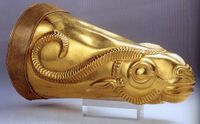
So far no evidence of Median existence in Hagmatana hill has been attested. Only evidence observed in the area belong to the Parthian era afterwards. [25] There is no mention of Hagmatana/Ecbatana in Assyrian sources at all. Some scholars have suggested the Sagbita/Sagbat frequently mentioned in Assyrian texts in fact has been an earlier form of the Ecbatana/Hagmatana mentioned in later Greek and Achaemenid sources, as Indo-Iranian /s/ turned into /h/ in many Iranian languages. Sagbita mentioned by Assyrian sources was located in proximity of cities of Kishesim (Kar-Nergal) and Harhar (Kar-Sharrukin) [26][27].
Under the Persian kings, Ecbatana, situated at the foot of Mount Elvend, became a summer residence. Later, it became the capital of the Parthian kings.
Sir Henry Rawlinson attempted to prove that there was a second and older Ecbatana in Media Atropatene on the site of the modern Takht-i-Suleiman, but the cuneiform texts imply that there was only one city of the name, and Takht-i Suleiman is the Ganzak|Gazaca of classical geography. Ecbatana was the main mint of the Parthians, it produced drachm, tetradrachm, and assorted bronze denominations. It is also mentioned in the Bible (Ezra, vi. 2).
Mention by Pliny
Pliny the Elder[28] writes....Ecbatana1, the capital of Media, was built2 by king Seleucus, at a distance from Great Seleucia of seven hundred and fifty miles, and twenty miles from the Caspian Gates.
1 A city of great magnitude, pleasantly situate near the foot of Mount Orontes, in the northern part of Greater Media. Its original foundation was attributed by Diodorus Siculus to Semiramis, and by Herodotus to Deioces. It was the capital of the Median kingdom, and afterwards the summer residence of the Persian and Parthian kings. The genuine orthography of the name seems to be Agbatana. The ruins seen at the modern Hamadan are generally supposed to represent those of the ancient Ecbatana; but it is most probable that at different times, if not contemporaneously, there were several cities of this name in Media.
2 Pliny in this statement, as also in the distances which he here assigns to Ecbatana, is supposed to have confounded Ecbatana with Europus, now Veramin, rebuilt by Seleucus Nicator.
Mention by Pliny
Pliny[29] mentions.....Adjoining the other front of Greater Armenia, which runs down towards the Caspian Sea, we find Atropatene7, which is separated from Otene, a region of Armenia, by the river Araxes; Gazæ8 is its chief city, distant from Artaxata four hundred and fifty miles, and the same from Ecbatana in Media, to which country Atropatene belongs.
7 There is great difficulty in ascertaining, from the accounts given by the ancient writers, the exact limits of this district, but it is supposed to have included a considerable portion of the province now known by the name of Azerbaijan. It derived its name from Atropates or Atropes, who was governor of this district under the last Darius.
8 Most probably the place now known as Gazæa, the royal residence of the Parthian kings, and, as its name would imply, their treasure city. Colonel Rawlinson thinks that this place underwent many changes of name according to the rulers who successively occupied it; among other names, it appears to have borne that of Ecbatana.
Mention by Pliny
Pliny[30] mentions 'Media and the Caspian Gates'....Ecbatana1, the capital of Media, was built2 by king Seleucus, at a distance from Great Seleucia of seven hundred and fifty miles, and twenty miles from the Caspian Gates.
1 A city of great magnitude, pleasantly situate near the foot of Mount Orontes, in the northern part of Greater Media. Its original foundation was attributed by Diodorus Siculus to Semiramis, and by Herodotus to Deioces. It was the capital of the Median kingdom, and afterwards the summer residence of the Persian and Parthian kings. The genuine orthography of the name seems to be Agbatana. The ruins seen at the modern Hamadan are generally supposed to represent those of the ancient Ecbatana; but it is most probable that at different times, if not contemporaneously, there were several cities of this name in Media.
2 Pliny in this statement, as also in the distances which he here assigns to Ecbatana, is supposed to have confounded Ecbatana with Europus, now Veramin, rebuilt by Seleucus Nicator.
Mention by Pliny
Pliny[31] mentions....A narrow passage which leads to Persepolis12, the former capital of the kingdom, destroyed by Alexander. It has also, at its extreme frontier, Laodicea13, founded by Antiochus. To the east of this place is the fortress of Passagarda14, held by the Magi, at which spot is the tomb of Cyrus; also Ecbatana15, a city of theirs, the inhabitants of which were removed by Darius to the mountains.
12 Which was rebuilt after it was burnt by Alexander, and in the middle ages had the name of Istakhar; it is now called Takhti Jemsheed, the throne of Jemsheed, or Chil-Minar, the Forty Pillars. Its foundation is sometimes ascribed to Cyrus the Great, but more generally to his son, Cambyses. The ruins of this place are very extensive.
13 Its site is unknown; but Dupinet translates it the "city of Lor."
14 The older of the two capitals of Persia, Persepolis being the later one. It was said to have been founded by Cyrus the Great, on the spot where he gained his victory over Astyages. Its exact site is doubtful, but most modern geographers identify it with Murghab, to the north-east of Persepolis, where there are the remains of a great sepulchral monument of the ancient Persians, probably the tomb of Cyrus. Others place it at Farsa or at Dorab-Gherd, both to the south-east of Persepolis, the direction mentioned by Strabo, but not in other respects answering his description so well as Murghab.
15 It is most probable that he does not allude here to the Ecbatana, mentioned in c. 17 of this Book.
Mention by Pliny
Pliny[32] mentions Tigris....Below31 this district is Susiane, in which is the city of Susa32, the ancient residence of the kings of Persia, built by Darius, the son of Hystaspes; it is distant from Seleucia Babylonia four hundred and fifty miles, and the same from Ecbatana of the Medi, by way of Mount Carbantus.33 Upon the northern channel of the river Tigris is the town of Babytace34, distant from Susa one hundred and thirty-five miles. Here, for the only place in all the world, is gold held in abhorrence; the people collect it together and bury it in the earth, that it may be of use to no one.35 On the east of Susiane are the Oxii, a predatory people, and forty independent savage tribes of the Mizæi.
32 Previously mentioned in c. 26.
33 A part of Mount Zagrus, previously mentioned, according to Hardouin.
34 Its site appears to be unknown. According to Stephanus, it was a city of Persia. Forbiger conjectures that it is the same place as Badaca, mentioned by Diodorus Siculus, B. xix. c. 19; but that was probably nearer to Susa.
Ch. 19: Darius pursued into Media and Parthia
Arrian[33]After bringing these matters to a successful issue, he advanced towards Media; for he ascertained that Darius was there. Now Darius had formed the resolution, if Alexander remained at Susa or Babylon, to stay there among the Medes, in order to see if any change of policy were made by Alexander. But if the latter marched against him, he resolved to proceed into the interior towards Parthia and Hyrcania, as far as Bactria, laying waste all the land and making it impossible for Alexander to advance any further. He therefore sent the women and the rest of the property which he still retained, together with the covered carriages, to what were called the Caspian Gates[1]; but he himself stayed at Ecbatana,[2] with the forces which had been collected from those who were at hand. Hearing this, Alexander advanced towards Media, and invading the land of the Paraetacae,[3] he subdued it, and appointed Oxathres, son of Abulites, the former viceroy of Susa, to rule as viceroy. Being informed on the march that Darius had determined to meet him for battle, and to try the fortune of war again (for the Scythians and Cadusians had come to him as allies), he ordered that the beasts of burden, with their guards and the rest of the baggage, should follow; and taking the rest of his army, he led it in order of battle, and on the twelfth day arrived in Media. There he ascertained that the forces of Darius were not fit for battle, and that his allies, the Cadusians and Scythians, had not arrived; but that he had resolved to flee. He therefore marched on with still greater speed; and when he was only three days' journey from Ecbatana, he was met by Bistanes, son of Ochus, who reigned over the Persians before Darius. This man announced that Darius had fled five days before, taking with him 7,000 talents of money[4] from the Medes, and an army of 3,000 cavalry and 6,000 infantry.
When Alexander reached Ecbatana, he sent the Thessalian cavalry and the other Grecian allies back to the sea, paying them the full hire which had been stipulated, and making them an additional donation from himself of 2,000 talents. He issued an order that if any man of his own accord wished still to continue to serve for hire with him, he should enlist; and those who enlisted in his service were not a few. He then ordered Epocillus, son of Polyeides, to conduct the rest down to the sea, taking other cavalry as a guard for them, since the Thessalians sold their horses there. He also sent word to Menes to take upon himself the duty of seeing that they were conveyed in triremes to Euboea, when they arrived at the sea.[5] He instructed Parmenio to deposit the money which was being conveyed from Persis in the citadel at Ecbatana, and to hand it over to the charge of Harpalus;[6] for he had left this man over the money with a guard of 6,000 Macedonians and a few horsemen and light-armed infantry to take care of it. He told Parmenio himself to take the Grecian mercenaries, the Thracians, and all the other horsemen except the Companion cavalry, and march by the land of the Cadusians into Hyrcania. He also sent word to Clitus, the commander of the royal squadron of cavalry, who had been left behind at Susa ill, that when he arrived at Ecbatana from Susa he should take the Macedonians who had been left there in charge of the money, and go in the direction of Parthia, where also he himself intended soon to arrive.
1. This was the principal pass through the Elburz mountains from Media into Hyrcania and Parthia.
2. This was the capital of Media, called in Chaldee Achmetha (Ezra vi. 2). The present city of Hamadan is on the same site. It is situated at the foot of Mount Orontes, and was used by the Persian and Parthian kings as their summer residence. It was surrounded by seven walls, each overtopping the one before it, from the outer to the inner, crowned with battlements of different colours. Its citadel was used as a royal treasury. Below it stood a splendid palace, with silver tiles, and adorned with wainscotings, capitals, and entablatures of gold and silver. These treasures, to the value of 4,000 talents, were coined into money by Antiochus the Great of Syria. See Herodotus, i. 98; Polybius, x. 27.
3. This tribe lived in the mountains between Media and Persis.
4. £1,700,000.
5. Curtius (v. 23) says that 6,000 Grecian mercenaries under Plato the Athenian met Alexander in Media, having marched up from Cilicia.
6. Diodorus (xvii. 80) says that the amount of treasure deposited at Ecbatana was 180,000 talents or £41,400,000.
Ecbatana in Syria
Ecbatana/Hamadan (Iran) is not to be confused with Ecbatana/Hamath (Syria) where Cambyses II is supposed to have died according to Herodotus.
मांडा साम्राज्य
एकबाताना (Ecbatana) - यह मांडा साम्राज्य (मांडा वंशज जाटों) की राजधानी थी जो अब ईरान में हमादान नाम से है।[34]
References
- See Perrot and Chipiez, History of Art in Persia (Eng. trans., 1892); M Dieulafoy, L'Art antique de Ia Perse, pt. i. (1884); J. de Morgan, Mission scientifique en Perse, ii. (1894).
- Template:1911 Please update as needed.
External links
Se also
References
- ↑ "Ecbatana | ancient city, Iran | Britannica". www.britannica.com.
- ↑ Nardo, Don. "Ecbatana." The Greenhaven Encyclopedia of Ancient Mesopotamia, edited by Robert B. Kebric, Greenhaven Press, 2007, pp. 97-98.
- ↑ Arrian: The Anabasis of Alexander/3b, Ch.19, f.n. 2
- ↑ Nardo, Don. "Ecbatana." The Greenhaven Encyclopedia of Ancient Mesopotamia, edited by Robert B. Kebric, Greenhaven Press, 2007, pp. 97-98.
- ↑ Brown, Stuart C. (1997). "Ecbatana". Encyclopaedia Iranica, Vol. VIII, Fasc. 1. pp. 80–84.
- ↑ Parthian Stations, S.No.6
- ↑ Foundation, Encyclopaedia Iranica. "Welcome to Encyclopaedia Iranica". iranicaonline.org.
- ↑ Brown 1997, pp. 80–84.
- ↑ Lendering, Jona (1996). "Ecbatana (Hamadan)".
- ↑ Brown, Stuart C. (1986). "Media and Secondary State Formation in the Neo-Assyrian Zagros: An Anthropological Approach to an Assyriological Problem". Journal of Cuneiform Studies. 38 (1): 107–119. doi:10.2307/1359955. JSTOR 1359955. S2CID 156425357.
- ↑ Grayson, Albert Kirk (2000). Assyrian and Babylonian Chronicles. Eisenbrauns. ISBN 978-1-57506-049-1. OCLC 954169399.
- ↑ Kia, Mehrdad (2016). The Persian Empire: A Historical Encyclopedia [2 volumes]. Santa Barbara, CA: ABC-CLIO. p. 18. ISBN 978-1-61069-390-5.
- ↑ Jameson, Michael H.; Frye, Richard N. (1964). "The Heritage of Persia". The Classical World. 57 (4): 155. doi:10.2307/4345268. JSTOR 4345268.
- ↑ Pseudo-Aristotle, De mundo
- ↑ Bunson, Matthew (2012). Encyclopedia of Ancient Rome. Facts On File. p. 183. ISBN 978-0-8160-8217-9.
- ↑ Sulimani, Iris (2011). Diodorus' Mythistory and the Pagan Mission: Historiography and Culture-heroes in the First Pentad of the Bibliotheke. Leiden: BRILL. p. 204. ISBN 9789004194069.
- ↑ Polybius. "Histories". penelope.uchicago.edu. 5.44.
- ↑ Plutarch. Alexander. 35.1.
- ↑ Pliny. Naturalis Historia. 31.17.
- ↑ Foundation, Encyclopaedia Iranica. "Welcome to Encyclopaedia Iranica". iranicaonline.org.
- ↑ Brown 1997, pp. 80–84.
- ↑ The Oxford Encyclopedia of Archaeology in the Near East. 1997. doi:10.1093/acref/9780195065121.001.0001. ISBN 978-0-19-506512-1.
- ↑ "Hamadan". Encyclopædia Britannica.
- ↑ Arrian: The Anabasis of Alexander/3b, Ch.19, f.n. 2
- ↑ CHN | News
- ↑ I.N. Medvedskaya, Were the Assyrians at Ecbatana?, Jan, 2002 [1]
- ↑ Were the Assyrians at Ecbatana? | International Journal of Kurdish Studies | Find Articles at BNET.com
- ↑ Natural History by Pliny Book VI/Chapter 17,fn.1
- ↑ Natural History by Pliny Book VI/Chapter 16
- ↑ Natural History by Pliny Book VI/Chapter 17
- ↑ Natural History by Pliny Book VI/Chapter 29
- ↑ Natural History by Pliny Book VI/Chapter 31
- ↑ Arrian: The Anabasis of Alexander/3b, Ch.19
- ↑ Jat History Dalip Singh Ahlawat/Chapter IV ,p.411

